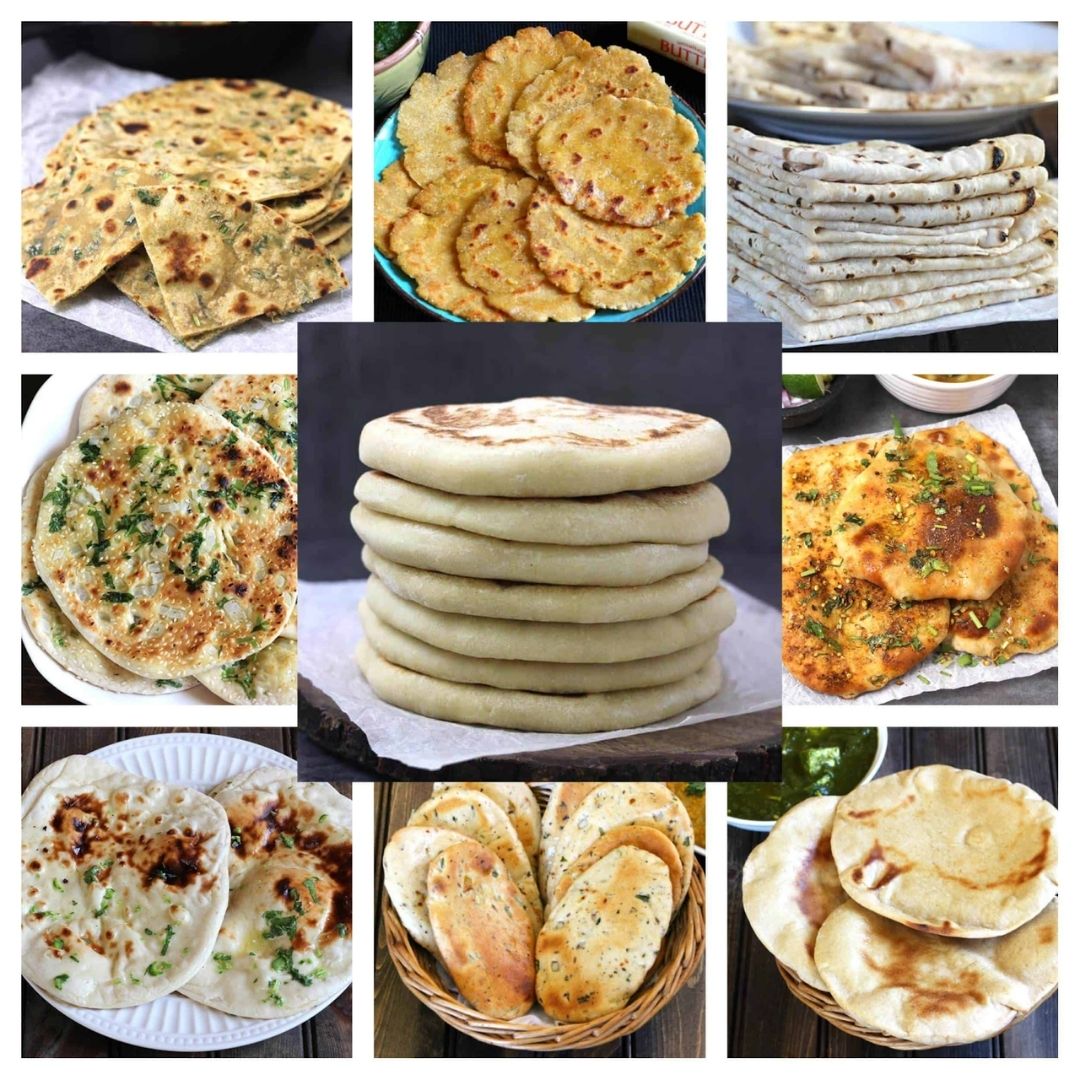Roti | Hindu flat bread
Roti has a myriad list of health benefits to offer and is enriched with nutrients such as vitamins (B1, B2, B3, B6, and B9), iron, calcium, phosphorus, magnesium and potassium.
Introduction
About this Recipe
The most well known recipe of India is the Indian flatbread commonly known as Roti. Roti is a round flatbread made from stone ground whole wheat flour or atta and water that is combined into a dough. Roti’s most defining characteristic is that it is unleavened and is hence considered healthy. In comparison, the bread in other parts of the world are made from refined flour using yeast as a raising agent.
Chapati, is a thinner softer variety of roti, made from whole-wheat flour, mixed into dough with water, edible oil and salt in a mixing utensil called a parat, and is cooked on the tava. Variations of the chapati are called phulka in Punjabi and Saraiki, and maani in Sindhi.
It is normally eaten with cooked vegetables or curries and is cooked/roasted on a flat or slightly concave iron griddle called a tawa. Rotis are also made from millet, maize, jowar and even rice flour.
A variant of the roti is the tandoori roti viz. cooked by sticking the flattened dough to the inside wall of a large clay oven called the tandoor, where it is baked quickly at high temperature. Some variations of the roti include the Naan, Kulcha, Paraatha, Laccha Paratha, Luchi, etc.
Roti is a staple food among the Indo-Carribean communities of Guyana, Suriname, Trinidad-Tobago and Jamaica, as well in Nepal, Pakistan, Bangladesh, Indonesia, Sri Lanka and Malaysia.
Flavor of roti or chapati is enhanced with a drizzle of oil or ghee. For added flavor carom, cumin, sesame, fennel, coriander seeds can be used, which are combined with ground spices such as chilli and turmeric. Vegetables such as carrots, spinach, fenugreek leaves, dill leaves, beetroot are used, making possible a truly wide variety of rotis. Roti is enhanced with fillings, both savoury and sweet, to make a wide variety of dishes. E.g. aloo paratha has a potato filling, gobi paratha a cauliflower filling, mooli paratha a radish filling, and so on. Other variations include puran poli which has sweet fillings, kachori which has mixed sweet-savory filling, and so on.
Roti has a myriad list of health benefits to offer and is enriched with nutrients such as vitamins (B1, B2, B3, B6, and B9), iron, calcium, phosphorus, magnesium and potassium. A plain roti is an excellent source of soluble fibre, which helps lower blood cholesterol levels, prevents constipation and helps keep the digestive system healthy. Loaded with complex carbohydrates that give you sustained energy and it can keep you satiated for hours.

“I WILL GIVE YOU A FEW UNDERSTANDINGS:
ENJOY THROUGH THE TONGUE WHICH YOUR WHOLE
INTESTINE ENJOYS. YOU WILL BE ‘YOGI’.
DON’T FORCE YOUR WHOLE INTESTINE TO TOLERATE
WHAT YOUR TONGUE ENJOYS. THEN YOU WILL BE JUST ‘ROGI’ (SICK)
YOGIS HAVE DEVELOPED A UNIQUE EATING STYLE WHICH IS TASTY
AND HEALTHY – THAT IS WHAT IS THE AGAMIC FOOD.
I WANTED THAT FOOD DESCRIBED IN THE BHAGA SHASTRA TO
BECOME THE LIFESTYLE, THE FOOD WHICH IS VERY HEALTHY AND
TASTY.
I WANTED BHAGA SHASTRA TO BECOME A LIFESTYLE – CHAIN OF
RESTAURANTS: EAT AS MUCH AS YOU WANT, DONATE AS MUCH AS YOU WANT.”
– SPH JGM Nithyananda Paramasivam
Preparation time: 15 mins
Set Aside time: 1.5 hours
Cooking time: 20 mins
Total time: 45 mins
Servings : 3-4 persons
Course: Main course
Cuisine: Northern India and Western India. It is an occasional dish in the rice-eating belts such as Southern and Eastern India.
Ingredients
- Wheat Grits or Flour -½ padi -750 gms
- Wheat Grits or Flour -½ padi -750 gms
- Ghee -1½ palam -52.5 ml
- Salt -⅜ palam -7 gms
- Water to make the dough

Bhaga Shastra gives ingredient measurements in measurement systems used in the olden days. Hence please use the conversion guidelines to convert it into modern measurement systems. When giving this recipe, we are not rounding any measurements in the modern units, so as to avoid any deviations from the Bhaga shastra. Go to this link for Bhaga Shastra Units Conversion to grams and kilograms:
Cooking Method
- Take a flat plate or parat (see pic below) and pour the wheat flour into it.
- Add salt and ghee.
- Mix all the above ingredients well by adding adequate water to make a uniform dough.
- Keep the dough aside for 1 ½ hour.
- Then again knead the dough well and make lemon sized balls of it.
- Dust the wheat flour on the board as well as on the roller before rolling to prevent it from sticking.
- Take one lemon sized ball and place it on a rolling board
- Roll the dough into a round shaped Roti with thickness of a half paddy.
- Place the tava (made of either clay or stone or iron) on fire. Put the roti on the tava to roast.
- Once it turns light brownish or if you can see the bubbles appearing on the roti, turn it to the other side. Make sure the edges of the rotis are also cooked well.
- Apply oil/ghee on the roti when it is hot.
- Follow the same steps for the rest of the dough. Stack the rotis one over the other, to keep them soft.
Note:
You may use your palms also to make the roti like thick pancakes.
While eating some people may apply ghee on the rotis to eat. Some people take 3-4 spoons of ghee and mix it with the same amount of water, heat it and then apply it to both sides of the rotis after it is cooked and taken off the pan. This helps to maintain the softness of the roti.
To retain softness, some people place the rotis in a container with a soft cloth wrapped on it and close it with a lid (as below)
Roti is normally eaten with any gravy, cooked vegetables, stew or dal (lentils) side dish or with sweet dishes made from fruits such as mangoes or bananas.
Roti is the staple dish in the Northern and Western states of India and is a necessary part of that ubiquitous and generous platter called the Indian thali, which is served with many accompaniments, including rice!
Step by step instructions
1
Take a flat plate or parat (see pic) and pour the wheat flour into it.

2
Add salt and ghee into it.

3
Mix together the flour with the ghee and salt added to it.

4
Now add water slowly to knead the wheat into a dough.

5
Make a smooth dough. Keep it aside for 1 & ½ hours. Knead the dough once again till it is soft to touch.

6
Take a roller board and roller pin (chakla & belan) normally used to roll rotis in India. Dust them with a little wheat flour to prevent the roti from sticking when it is rolled.

7
Make the dough into small size ball (size of ball can differ depending on size and thickness of roti required)

8
Roll the roti into a round shape, with thickness you desire and put it onto the iron girdle (tava) placed on the stove.

9
Roast the roti on both sides till they are done.

10
Apply ghee/oil on the roti, for softness, and stack them one over the other.

11
Rotis are now ready to be served with a gravy or side dish you can prepare for it.

